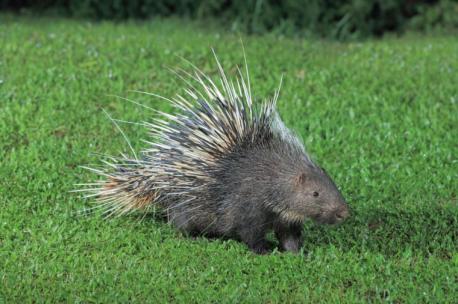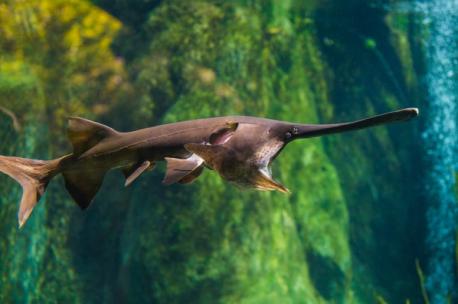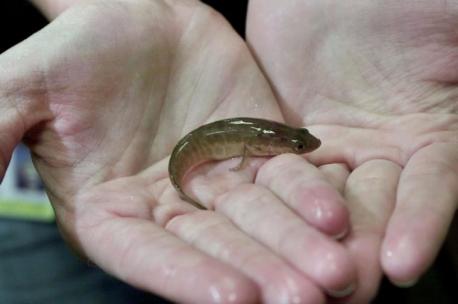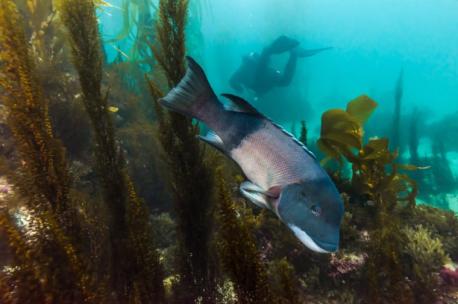Results: Strangest Animal Found in Each State (Part Eight)
Published on 08/14/2020
During one of my previous survey series someone suggested animals. Well here we go! Whether they look funny, act weird, adapted awkwardly, sound strange, or just seem out of place (or from the pages of a science-fiction novel), these bizarre beasts earned their state's spot on this unusual list.

QUESTIONS
GO to COMMENTS
Comments
1.
1.
Oklahoma: Ringtail - If you are lucky enough to catch a glimpse of these timid and tiny (usually weighing only a pound or two and are 24 inches in length) nocturnal animals, it's likely you'll mistake them for a really pretty housecat, an escaped zoo lemur thanks to oversized eyes and a long ringed tail of 14 to 16 black-and-white stripes, or for a fox because of their pointy muzzle and whiskers. But they are relatives of coatis and raccoons. They are great climbers. According to the Arizona-Sonora Desert Museum, having the ability to rotate their back paws 180 degrees allows them to ascend walls, trees, cliffs, and even cacti. Their ears have also adapted to move independently so ringtails can listen to what's happening in front and behind them simultaneously. Have you heard of this animal before this survey?

Yes
23%
534 votes
No
77%
1763 votes
2.
2.
Oregon: Porcupine - Generally found in the eastern half of the state and occasionally west of the Cascade Mountains according to OregonLive.com, it is best not to mess with porcupines. Covered in up to 30,000 sharp, barbed quills they use for defense, studies show the large, slow rodents are intelligent, able to learn, and have long memories, especially of mistreatment according to National Geographic. If rattling their quills doesn't scare off predators, they will ram backward into them as the quills cannot be shot out of the body. They do however grow back over time. They don't ask for trouble and are herbivores, but have been seen chewing on animal bones to sharpen their teeth and intake minerals like salt and calcium to stay healthy. Have you heard of this animal before this survey?

Yes
71%
1642 votes
No
29%
655 votes
3.
3.
Pennsylvania: American paddlefish - Don't call it a comeback. The paddlefish has been here for years—since the Paleozoic era (300 to 400 million years ago) to be precise. Fossil evidence of this long-snouted filter-feeding fish is millions of years old. The paddle, which is longer than the rest of its head and flat on the top and bottom, might be a touch organ or it may help stabilize the fish when its jaw is extended. Strangely, young paddlefish do not have the trademark rostrum. They also have teeth while the adult versions, which can weigh more than 200 pounds, do not. Have you heard of this animal before this survey?

Yes
22%
502 votes
No
78%
1795 votes
4.
4.
Rhode Island: Northern snakehead - National Geographic warns about the perils of ignoring this aggressive invasive fish with reptilian coloring, razor-sharp teeth that can tear human flesh, ravenous appetites, and an ability to be amphibious. That's right, these bad boys cannot only survive on land for three days using a primitive lung above their gills, they can walk on it by rhythmically swinging their muscular bodies and fins back and forth. Also a problem: snakeheads reach sexual maturity by two or three, mate up to five times a year, and can release 15,000 eggs at once. Have you heard of this animal before this survey?

Yes
16%
370 votes
No
84%
1927 votes
5.
5.
South Carolina: Sheepshead fish - Sheepshead fish, which can be found in waters from Massachusetts to Brazil, look like a genetic experiment gone wrong thanks to its human teeth. A Scientific American blog post explains that fully-grown convict fish—a nickname inspired by the distinctive black bars running down their silvery bodies—have well-defined incisors at the front of their jaw, multiple rows of molars, and strong grinders at the back. As with humans, this unique combination of choppers allows them to bite into armored prey like clams, crabs, and barnacles. Talk about a killer smile. Have you heard of this animal before this survey?

Yes
19%
426 votes
No
81%
1871 votes
COMMENTS


